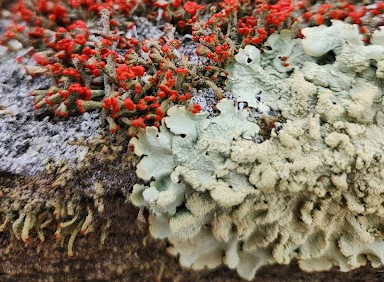When hiking in the woods in winter, it is easier to see details one might overlook during the warmer months. In the absence of leaves and flowers, things like the textures of bark, the beauty of different shades of brown, and the shapes of rocks stand out more boldly. One such star of the bleak midwinter are lichens.
Not to be confused with moss, mold or other mushrooms, lichen is one of many types of living being you might find growing on a tree’s bark, a downed log, boulder or cliff face. Lichens come in just about every color from pale blues and greens, to electric yellows and vibrant reds. They take the shape of crusts and frills, cups, sponges and tufts. They are an ancient life form, with a long history of shaping our terrestrial world. What’s more, their existence radically changed science in the 1870s and continues to be the subject of scientific fascination today.
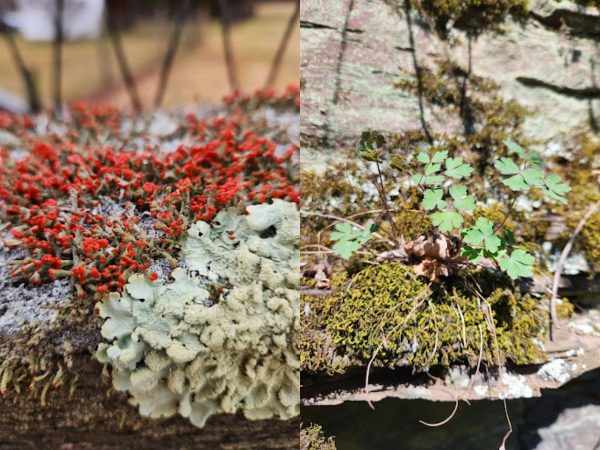
Left: Two lichens, a pixie cup lichen and a foliose lichen, grow on a fence rail in Buckingham Township. Right: Moss and a small eastern columbine plant grow on a rocky face surrounded by a white-teal crustose lichen, found in Warwick Township. While lichen and plants are often found together and can look similar, it is important to remember that lichens are in an entirely different kingdom of life than plants.
The Basics
Defining a lichen can be hard and often says more about the definer than the defined. At first glance, an individual lichen appears to be a plant-like organism. For many years science accepted that definition. Then the invention and refinement of microscope technology allowed us to take a deeper look. Upon closer inspection, the individual is in fact a miniature ecosystem.
A lichen is at once a single organism, a hybrid colony, and an ecological strategy. In the simplest terms, a lichen is the collaborative union of a fungus (called the mycobiont) and an alga or cyanobacteria (called the photobiont). However, the species, number and type of the partners involved can all vary drastically.
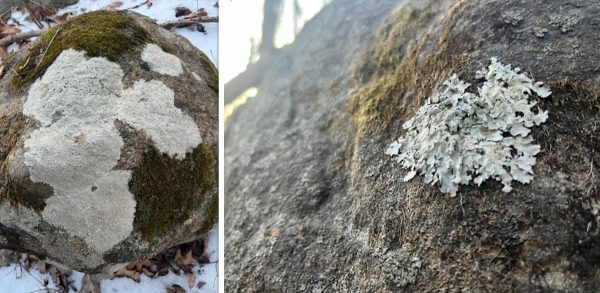
Each partner brings a different skill to the team. The photobiont creates food using photosynthesis when provided sufficient water and sunlight. Meanwhile the mycobiont uses its hyphae to anchor the team to the surface they are growing on, extract trace mineral nutrients from the environment, and protect the other partner(s) from the elements. This body of hyphal strands is often also called the thallus. By working together these partners are able to survive and thrive in harsh conditions.
Lichens are such an excellent example of interspecies collaboration that they inspired a German botanist to create the word “symbiosis” in 1877 to give science a way to describe this newly discovered phenomenon. The discovery that two or more very distantly related species could – and regularly do – form mutually beneficial relationships with each other was a radical idea in the aftermath of Darwin’s theory of evolution, which placed competition as the primary driver of improvement in a species’ survival fitness.
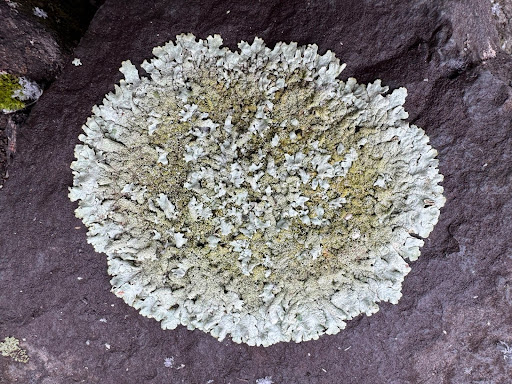
Player Profiles
To really appreciate the impressiveness of the teamwork that is a lichen, it is necessary to compare just how evolutionarily different each of the participants are from each other. Sure, algae, cyanobacteria, and fungi all seem fairly similar to each other compared to a mammal like us, but that fungal symbiont is actually more closely related to us than it is to either the algae or cyanobacteria it lives with.
Cyanobacteria are the oldest lineage involved here. The Earth is estimated to be about 4.54 billion years old, and cyanobacteria have been around for most of that time. They first showed up in Earth history about 3.5 billion years ago. These tiny single-cell organisms are responsible for inventing photosynthesis and oxygenating the planet.
By comparison, algae and fungi are both “eukaryotes,” meaning their cells have organelles each performing specialized functions (think nucleus, mitochondria, chloroplasts, the golgi apparatus, etc.), a feature which didn’t evolve until 1.85 billion years ago. Algae only came along once an early eukaryote absorbed a cyanobacteria and kept that cyanobacteria alive within itself in exchange for the cyanobacteria’s photosynthesized sugars, an event that took place about 1.6 billion years ago. Algae ultimately displaced cyanobacteria as the ocean’s primary photosynthesizers, and then gave rise to the rest of the plant kingdom.
Finally, fungi started taking form around 1.5-1 billion years ago. All of these organisms lived and evolved independently from each other long before the first lichens formed 419-358 million years ago. Their evolutionary divergence allowed them to each develop different skills and makes their ability to collaborate all the more impressive.
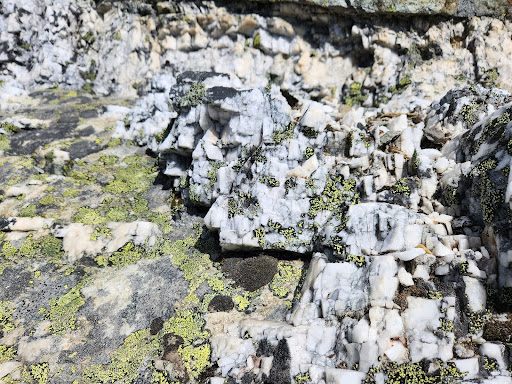
Their Super Powers
Beyond pioneering the idea of symbiosis within the field of evolutionary ecology, lichens are literal pioneer species on Earth and beyond.
The foundation for terrestrial life on Earth is soil. Without soil, most plants can’t grow, and without plants, there is very little for anyone else to eat. Soil is a combination of mineral particulates, and organic material. In order for soil to form, there has to be a process by which rocks are broken down and the resulting particulates are mixed with the byproducts of life – dead organisms and excrement.
Lichen are one way that soil formation process takes place. Fungi generally are quite good at mining mineral nutrients out of rocks using enzyme exudates. But fungi are consumers, meaning they need a food source, whether that is a dead organism, or a living one that it is trading with or parasitizing. As lichens, the fungi are fueled by their photobiont partner(s) who travel and grow with them. Together the lichen team can colonize large swaths of exposed rock and slowly break down those rocks. When lichen die, their bodies breakdown and mix with the fragments of rock, creating soil.
Lichens have found ways to survive in some of Earth’s harshest environments, from arctic tundra to rocky shorelines to deserts. In their evolutionary experimentation, some lichens have developed survival adaptations that have proven effective even in outer space. In 2005, three lichen species were exposed directly to outer space, attached to the outside of a satellite, for 10 days. Upon their return to Earth, all three returned to normal functioning, alive and well. The experiment was repeated on the International Space Station in 2008-2009. This time the lichen samples survived in outer space for 18 months, and upon returning to Earth were completely fine.
Other lichen species are indicators of environmental harm, like air pollution, lead contamination, and fire history. For example, many species of lichen are sensitive to increases in sulfur dioxide, an air pollutant introduced into our atmosphere primarily by the burning of fossil fuels. When local sulfur dioxide levels rise for an extended period of time, lichen diversity declines, meaning that the sensitive lichen species die off, leaving only the hardiest, most tolerant species behind.
The Clean Air Act in the US has been great for lichen and human health alike by setting National Ambient Air Quality Standards, which the EPA monitors and then works with state, local, and tribal governments in non-compliant areas to implement control strategies.
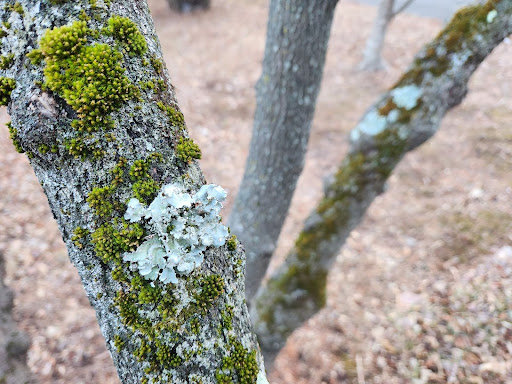
Finding Them IRL (In Real Life)
Lichens grow on rocks, trees, fences – basically anywhere they can get a foothold (or should I say a hyphae-hold?). They can even on live Galapagos tortoises, though you don’t need to travel to a distant island to see them. Just take a walk through your local park, nature preserve, or tree-lined boulevard and you’ll likely encounter at least one of the roughly 3,600 lichen species that call North America home.
If you find lichen growing on a tree in your yard, no need to panic. While some fungi can stress or even kill trees, lichens do not have this detrimental effect. Instead, take a moment to look closer at this tiny world. Notice its peaks and valleys, the subtle shifts in its color. Appreciate the hard work the fungi has put into negotiating its tri-part job – anchor, protector, collector – and the elegance with which it has succeeded so far.
Consider the algae growing just beneath the surface, a miniature version of the plants around you. That algae is likely unaware of the world beyond its protective fungal cocoon, sheltered from UV radiation by the hyphae above it like we are by the ozone layer above our heads. To leave its fungal partner, the algae would likely die, exposed to the elements. We, too, risk death when we leave our protective, life-sustaining atmosphere for the space beyond it.
In a way, we build a thallus around ourselves when we venture into space, a metal version of the climate-controlled fungal vessel within which algae have traveled from the water onto land. The life experience of a lichen may be unknowable and foreign to us, but there is still a similarity that binds and connects us. We are two earthling life forms, each an amalgamation of body and microbes, trying to find new ways to make a living on our ever changing planet.
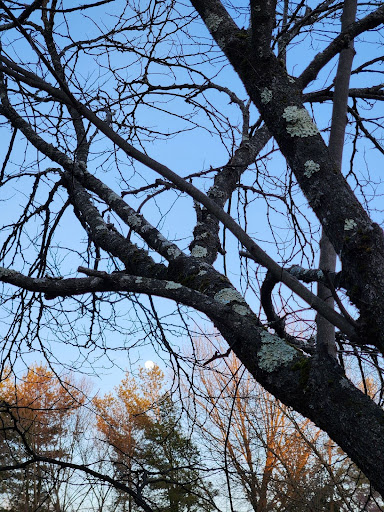
Author Katie Toner is a one of Heritage Conservancy’s Conservation Easement Stewards. Read more mind-blowing biology stories in our Nature Notes.
